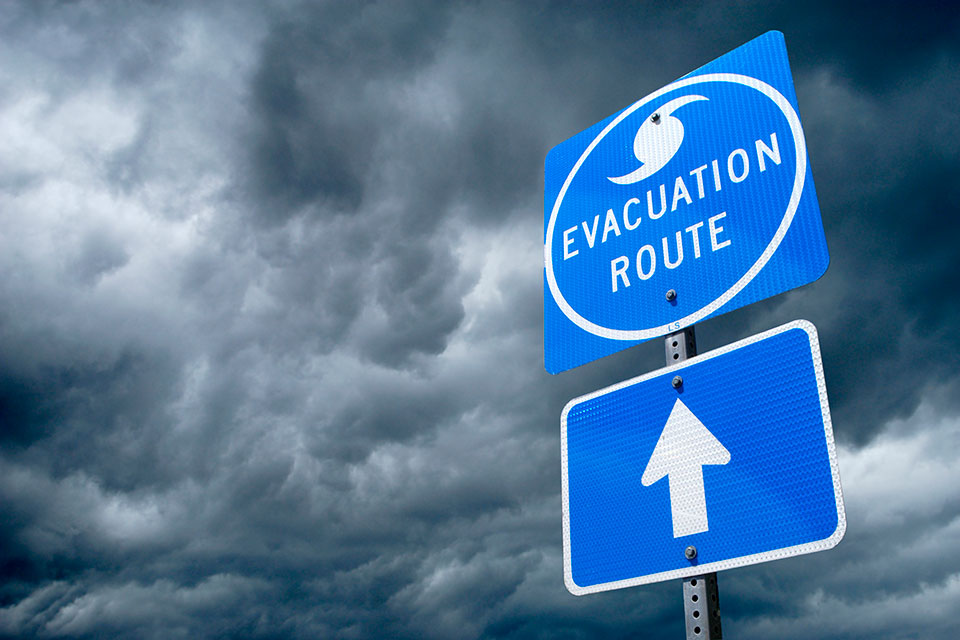6 things your business needs to do before tornado season.
Tornadoes can strike any time from early spring through late summer, but June 12 is considered the peak of the tornado season. So we gathered some tornado safety tips in the workplace to safeguard your employees. These six steps will help you implement a severe weather safety plan — including a tornado preparedness checklist — so your business is ready.
1. Know the danger.
The first step in protecting you and your fellow employees is to understand the danger you face and the level of urgency. There are two types of tornado alerts issued by the National Weather Service:
- Tornado Watch — This means a tornado is likely to occur in the watch area. Make sure you're ready to take shelter. You should also stay tuned to radio and television stations for updated information.
- Tornado Warning — This means a tornado has been sighted or has appeared on local radars. You and your fellow employees need to get to a shelter right away.

2. Have a plan.
Every company should have a severe weather safety plan. For helpful strategies you can include in your plan, see below. But remember, any plan is better than no plan at all. At the very least, alert employees about where they should go if severe weather or a tornado is in the area.
- Develop a way to monitor who's in the building.
- Create an alarm system to warn workers, then test the system frequently.
- Think about how employees with disabilities and those who don't speak English will be warned.
- Account for workers, visitors, and customers as they arrive in the shelter. A good way to do this is to have an employee roster and then take a head count.
3. Assign roles.
Make sure people clearly understand their roles and responsibilities. For instance, who will sound the "official" office alert and who will make sure all your co-workers have made it to the shelter? You should:
- Assign specific duties to employees. You may even want to have checklists for each specific responsibility and go over the lists during training.
- Designate and train alternates in case an assigned person is sick or injured.
4. Train for it.
A plan is only a piece of paper until everyone knows how to implement it. So hold a training session at least once a year. The best time is in late winter/early spring just before the tornado season. That way, your plan will be fresh in people's minds when tornadoes are most likely to occur. Make time to:
- Ensure all workers know what to do in case of an emergency.
- Practice your shelter-in-place plan.
- Update plans and procedures based on lessons learned from exercises.
5. Stock up on equipment.
It's always wise to plan for the worst possible outcome. In the case of a tornado, that would be the loss of power and seriously injured employees who are stranded for a long time. Prepare for this contingency by using the following tornado preparedness checklist to gather the items you'll need:
- Emergency preparedness kit with first aid items
- 3-day supply of water — a gallon for each person each day
- 3-day supply of non-perishable food with a can opener if needed
- Battery-powered or hand crank radio and a NOAA Weather Radio with extra batteries
- Flashlight and extra batteries
- Whistle to signal for help
- Dust mask, plastic sheeting and lots of duct tape for sheltering in place
- Moist towelettes and garbage bags for personal sanitation
- Wrench or pliers to turn off utilities
- Solar-powered cell phone charger
6. Have a post-disaster plan.
After the severe weather or tornado has passed, the aftermath can be chaotic... and scary. Try to stay calm. Once the storm is over:
- See if anyone is injured. Start first aid or get help if necessary.
- Check utility lines and appliances for damage. If you smell gas, open the windows and turn off the main valve. Don't turn on lights or appliances until the gas has dissipated. If electric wires are shorting out, turn off the power.
- Look for downed power lines when you go outside.
- Call your insurance agent as soon as possible to report property damage.
- Keep receipts for all repairs so you can seek insurance reimbursement.
Put the safety of your co-workers first. If you haven't already, put a severe weather safety plan and tornado preparedness checklist in place. Then you'll be ready for whatever Mother Nature sends your way. For more tornado safety tips in the workplace, see these OSHA and FEMA resources.
Krista Wolfe
Quill.com Contributing Writer
Krista Wolfe is a marketing project manager for Quill.com where she writes to help small businesses, teachers and healthcare professionals make more informed decisions on office essentials. She also writes on our new community blog, Café Quill, about a wide range of business matters such as leadership, productivity and work-life balancing. Krista lives in Chicago and you can find her on LinkedIN.



